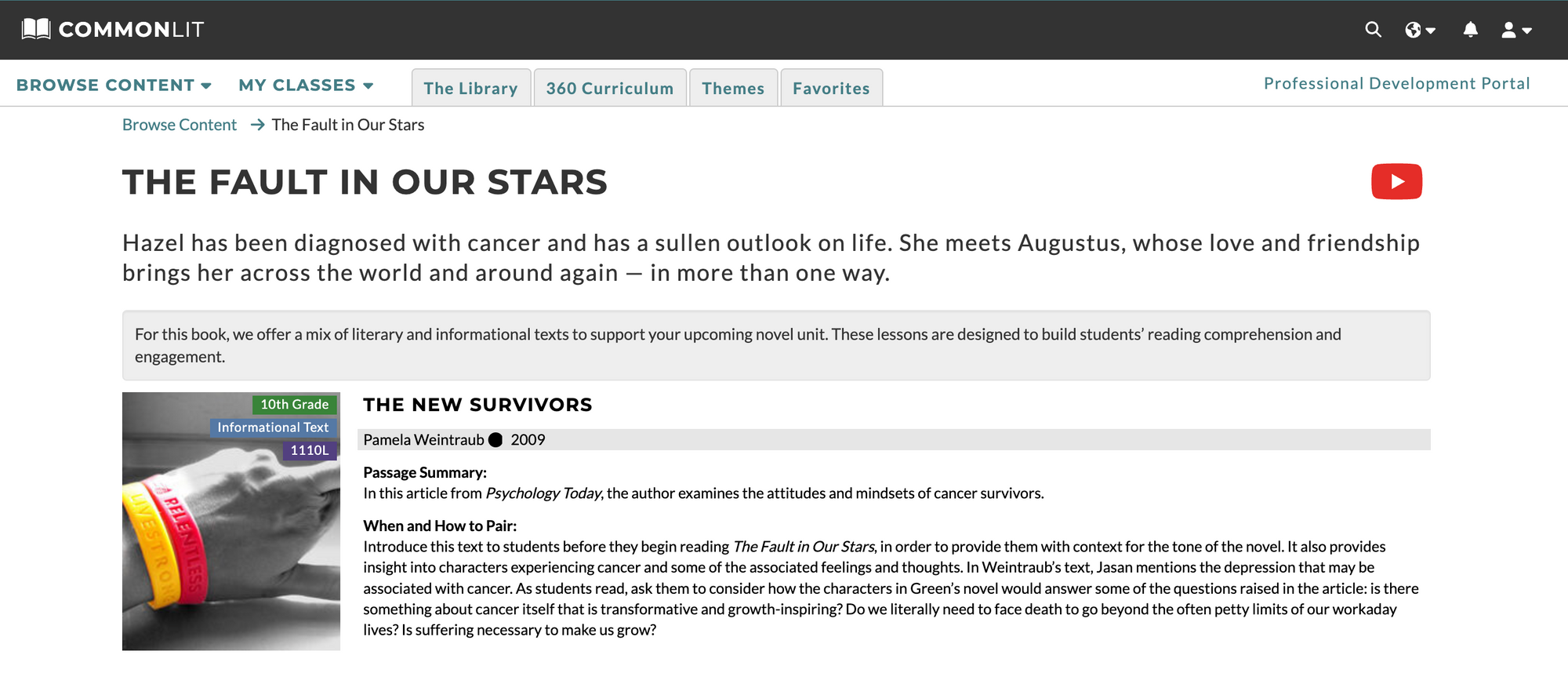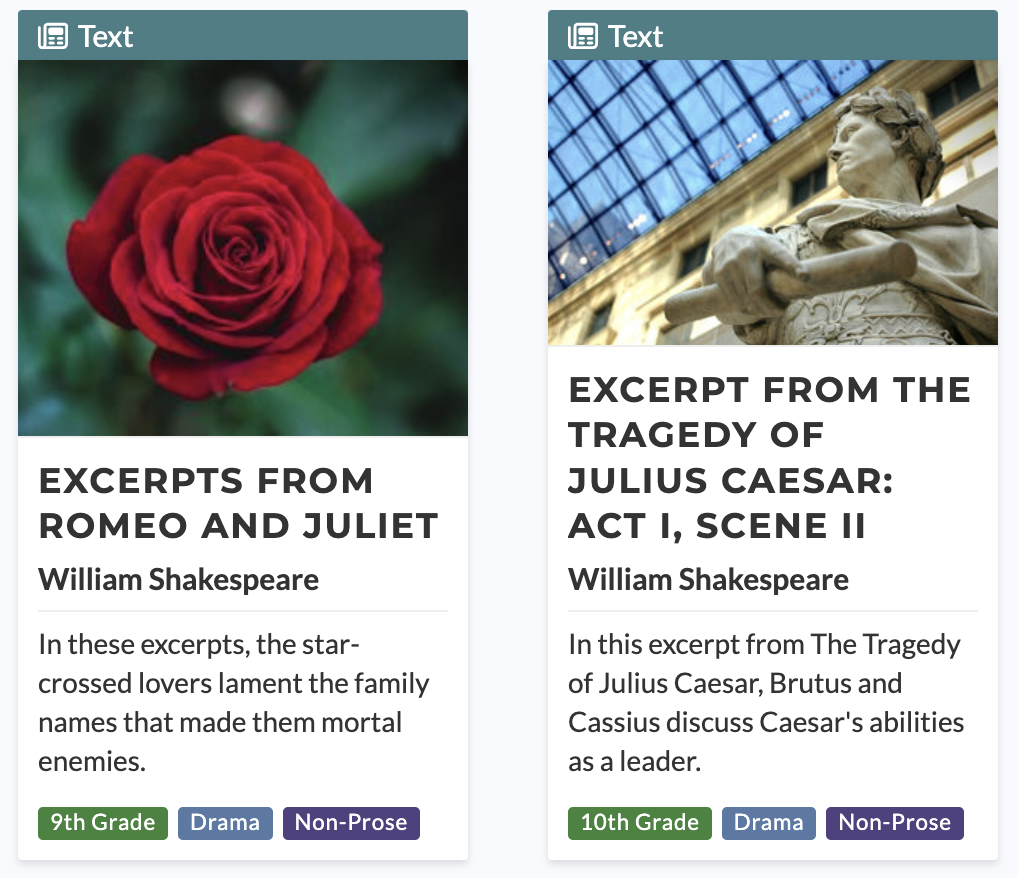Treat your class to this classic young adult romance novel and boost their reading comprehension as you go!
The CommonLit digital literacy program has thousands of high-quality lessons that will engage your students while simultaneously meeting ELA standards. Additionally, we offer over one hundred Book Pairings for your classroom. Every Book Pairing is tailored to the specific novel. Pairings include information about the new text, where to introduce the text to students, and discussion questions to bring the novel and the supplemental passage together.
The Fault in Our Stars by John Green follows the life of Hazel Grace Lancaster, a high school student grappling with lung cancer. In this young adult novel, Hazel has been living with cancer for years when she meets Augustus Waters, another cancer patient. Against Hazel’s better judgment, the pair falls in love and struggles with a love story that is framed by a shortened life expectancy.
Detangling Complicated Emotions in The Fault in Our Stars
Hazel and Augustus experience complex emotions like joy, depression, and love, as they navigate their journeys with cancer. Help students untangle the web of emotions that John Green spins using these informational and literary texts.
“The New Survivors” by Pamela Weintraub
In this article, the author examines the attitudes and mindsets of cancer survivors. Some cancer patients who survive have an increased sense of mortality, which leads to a more positive outlook on life.
Begin your novel unit using this text to give students context for the tone of the book. Once students begin to read, ask them to consider how characters from The Fault in Our Stars would respond to the questions raised in the article, “Is there something about cancer itself that is transformative and growth-inspiring? Do we need to face death to go beyond the often petty limits of our workaday lives? Is suffering necessary to make us grow?”

“There’s a certain Slant of Light” by Emily Dickinson
In Emily Dickinson's poem, a speaker describes the effects of a slant of light on a winter day. The speaker finds winter, and winter light to be an oppressive force. Additionally, winter could also be a metaphor for the greater challenges we face.
Introduce this poem after students have read chapter seven. The title of Hazel’s favorite novel, An Imperial Affliction, comes from this poem. Ask students to draw connections between the speaker in the poem and Hazel. Could this poem be a metaphor for Hazel’s life? Does the “imperial affliction” in Dickinson’s poem apply to Hazel?
“Here We Aren’t, So Quickly” by Jonathan Safran Foer
In this avant-garde short story, a man reflects on his life and his relationship with his family. His story does not follow the normal narrative structure of happily ever after. Instead, as his relationship with his wife ebbs and flows over the years, he realizes change is the only constant.
Introduce this text after students have read chapter 22. This chapter addresses the juxtaposition of mortality and love. Hazel reflects on the phrase: “without pain, we couldn’t know joy.” Both the man in An Imperial Affliction and Hazel ultimately conclude that love is worth the pain that accompanies it. Ask students to discuss this concept. Why is love a worthy pursuit in the eyes of each author?
Interacting with Destiny:
Hazel and Augustus are modern-day star-crossed lovers. Ask students to consider fate and destiny as they read the novel alongside these supplemental texts on love and kismet.
“Excerpt from the Tragedy of Julius Caesar: Act I, Scene II” by William Shakespeare
In this Shakespeare excerpt, Cassius discusses Julius Caesar's shortcomings with Brutus, hoping to convince him that Caesar is a poor leader.
Introduce this text after students have read chapter 12. In this chapter, Augustus and Hazel visit Hazel’s favorite author, Peter Van Houten, who has become bitter due to the losses he has experienced. His assistant thinks Van Houten has chosen to become a terrible person. In Shakespeare’s play, Cassius tells Brutus that they owe their unfortunate status not to fate, but to their own failure to take action. Have students discuss the symbol of the mirror discussed between Brutus and Cassius. How does Augustus serve as Hazel’s mirror?

“Excerpts from Romeo and Juliet” by William Shakespeare
In these excerpts from Romeo and Juliet, two young lovers face a devastating truth. Because of their family name, they are sworn to be mortal enemies. However, the couple declares their love for one another, regardless of their family ties.
Have students read this excerpt after finishing chapter 20 of The Fault in Our Stars. Both Romeo and Juliet and Hazel and Augustus are referred to as “star-crossed lovers,” which alludes to an element of fate. Ask students to consider Romeo and Juliet’s relationship. Features of their relationship have direct parallels to Hazel and Augustus’s relationship. How does love, commitment, and youth shape these characters and the decisions they make?
“The Road Not Taken” by Robert Frost
In this poem, the narrator reflects on their choice to take one path over another. The speaker in the poem tries to explain the choice they made and realizes there’s no way to really tell if it was the right choice.
Introduce this poem to students after they have completed the novel. The novel ends with Augustus and Hazel declaring that they are happy in their choice to have loved and lost rather than never to have loved at all. Have students analyze the poem for its message on embracing uncertainty. How does the ending of the novel, where Augustus confronts Peter Van Houten about his choices, support Frost’s message?
Next Steps
Explore our digital library for more great young adult book pairings or use the genre feature to find poems, informational texts, and short stories about love!
If you’re interested in learning all about CommonLit’s free reading program, join one of our upcoming webinars!


